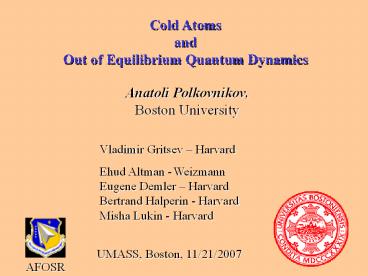Cold Atoms and Out of Equilibrium Quantum Dynamics - PowerPoint PPT Presentation
Title:
Cold Atoms and Out of Equilibrium Quantum Dynamics
Description:
Cold Atoms and Out of Equilibrium Quantum Dynamics Anatoli Polkovnikov, Boston University Vladimir Gritsev Harvard Ehud Altman - Weizmann Eugene Demler Harvard – PowerPoint PPT presentation
Number of Views:169
Avg rating:3.0/5.0
Title: Cold Atoms and Out of Equilibrium Quantum Dynamics
1
Cold Atoms and Out of Equilibrium Quantum
Dynamics
Anatoli Polkovnikov, Boston University
Vladimir Gritsev Harvard Ehud Altman
- Weizmann Eugene Demler Harvard Bertrand
Halperin - Harvard Misha Lukin - Harvard
UMASS, Boston, 11/21/2007
AFOSR
2
Cold atoms (controlled and tunable Hamiltonians,
isolation from environment)
Experimental examples
3
Optical Lattices
I. Bloch, Nature Physics 1, 23 - 30 (2005)
OL are tunable (in real time) from weak
modulations to tight binding regime. Can change
dimensionality and study 1D, 2D, and 3D
physics. Both fermions and bosons.
4
Superfluid-insulator quantum phase transition in
interacting bosons.
5
Repulsive Bose gas.
Lieb-Liniger, complete solution 1963.
M. Olshanii, 1998
interaction parameter
Experiments
T. Kinoshita, T. Wenger, D. S. Weiss ., Science
305, 1125, 2004
Also, B. Paredes1, A. Widera, V. Murg, O. Mandel,
S. Fölling, I. Cirac, G. V. Shlyapnikov, T.W.
Hänsch and I. Bloch, Nature 277 , 429 (2004)
6
Energy vs. interaction strength experiment and
theory.
No adjustable parameters!
Kinoshita et. Al., Science 305, 1125, 2004
7
Local pair correlations.
Kinoshita et. Al., Science 305, 1125, 2004
8
Cold atoms (controlled and tunable Hamiltonians,
isolation from environment)
9
(No Transcript)
10
In the continuum this system is equivalent to an
integrable KdV equation. The solution splits into
non-thermalizing solitons Kruskal and Zabusky
(1965 ).
11
Qauntum Newton Craddle.(collisions in 1D
interecating Bose gas Lieb-Liniger model)
T. Kinoshita, T. R. Wenger and D. S. Weiss,
Nature 440, 900 903 (2006)
12
Cold atoms (controlled and tunable Hamiltonians,
isolation from environment)
3. 12 Nonequilibrium thermodynamics?
13
Adiabatic process.
Assume no first order phase transitions.
14
Adiabatic theorem for integrable systems.
Density of excitations
15
Adiabatic theorem in quantum mechanics
Landau Zener process
In the limit ??0 transitions between different
energy levels are suppressed.
This, for example, implies reversibility (no work
done) in a cyclic process.
16
Adiabatic theorem in QM suggests adiabatic
theorem in thermodynamics
- Transitions are unavoidable in large gapless
systems. - Phase space available for these transitions
decreases with d.Hence expect
Is there anything wrong with this picture?
Hint low dimensions. Similar to Landau expansion
in the order parameter.
17
More specific reason.
- Equilibrium high density of low-energy states
-gt - strong quantum or thermal fluctuations,
- destruction of the long-range order,
- breakdown of mean-field descriptions,
Dynamics -gt population of the low-energy states
due to finite rate -gt breakdown of the adiabatic
approximation.
18
This talk three regimes of response to the slow
ramp
- Mean field (analytic) high dimensions
- Non-analytic low dimensions
- Non-adiabatic lower dimensions
19
Example crossing a QCP.
? ? ? t, ? ? 0
Gap vanishes at the transition. No true adiabatic
limit!
How does the number of excitations scale with ? ?
20
Transverse field Ising model.
Phase transition at g1.
Start at ggtgt1 and slowly ramp it to 0. Count the
number of domain walls
Critical exponents z?1 ? d?/(z? 1)1/2.
A.P. 2003, W. H. Zurek, U. Dorner, P. Zoller
2005, J. Dziarmaga 2005
21
Possible breakdown of the Fermi-Golden rule
(linear response) scaling due to bunching of
bosonic excitations.
Hamiltonian of Goldstone modes superfluids,
phonons in solids, (anti)ferromagnets,
In superfluids ? is determined by the
interactions.
Imagine an experiment, where we start from a
noninteracting superfluid and slowly turn on
interaction.
22
Zero temperature regime
Energy
Assuming the system thermalizes at a fixed energy
23
Finite Temperatures
d1,2
Non-adiabatic regime!
d3
Artifact of the quadratic approximation or the
real result?
24
Numerical verification (bosons on a lattice).
Nonintegrable model in all spatial dimensions,
expect thermalization.
25
Quantum expansion of dynamics
Leading order in ? start from random initial
conditions distributed according to the Wigner
transform of the density matrix and propagate
them classically (truncated Wigner approximation)
26
T0.02
27
Thermalization at long times.
28
2D, T0.2
29
Conclusions.
Three generic regimes of a system response to a
slow ramp
- Mean field (analytic)
- Non-analytic
- Non-adiabatic
Open questions general fate of linear response
at low dimensions, non-uniform perturbations,
30
M. Greiner et. al., Nature (02)
Adiabatic increase of lattice potential
What happens if there is a current in the
superfluid?
31
Drive a slowly moving superfluid towards MI.
32
Meanfield (Gutzwiller ansatzt) phase diagram
Is there current decay below the instability?
33
Role of fluctuations
Phase slip
Below the mean field transition superfluid
current can decay via quantum tunneling or
thermal decay .
34
1D System.
variational result
semiclassical parameter (plays the role of 1/ )
N1
Large N102-103
C.D. Fertig et. al., 2004
Fallani et. al., 2004
35
Higher dimensions.
Longitudinal stiffness is much smaller than the
transverse.
r
Need to excite many chains in order to create a
phase slip.
36
Phase slip tunneling is more expensive in higher
dimensions
37
Current decay in the vicinity of the
superfluid-insulator transition
38
Use the same steps as before to obtain the
asymptotics
Discontinuous change of the decay rate across the
meanfield transition. Phase diagram is well
defined in 3D!
Large broadening in one and two dimensions.
39
Detecting equilibrium SF-IN transition boundary
in 3D.
p
Easy to detect nonequilibrium irreversible
transition!!
At nonzero current the SF-IN transition is
irreversible no restoration of current and
partial restoration of phase coherence in a
cyclic ramp.
40
J. Mun, P. Medley, G. K. Campbell, L. G.
Marcassa, D. E. Pritchard, W. Ketterle, 2007
41
Conclusions.
Three generic regimes of a system response to a
slow ramp
- Mean field (analytic)
- Non-analytic
- Non-adiabatic
Smooth connection between the classical dynamical
instability and the quantum superfluid-insulator
transition.































